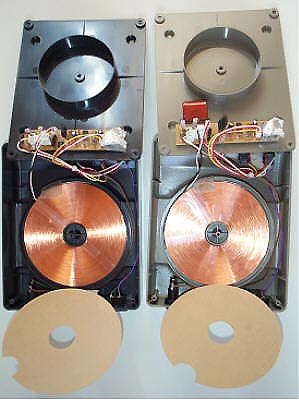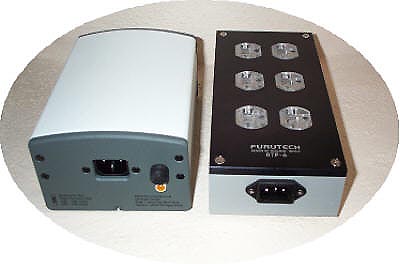 |
|||||||||||||||||||
|
Last month, I wrote about two Furutech components, the RD-2 CD-DVD degausser and the RTP-6 power strip. The virtual ink hadn't so much as dried yet when two readers offered to loan me an RD-1 and PS Audio Ultimate Outlet for two separate egghead-to-egghead comparisons to see who'd crack. The war of the magnets |
|||||||||||||||||||
 |
 |
||||||||||||||||||
|
Both units share the same soft-edged, attractively contoured mold for the hard plastic body. But sex appeal has gone uptown, from white lettering on charcoal to gold on platinum. The guts look virtually identical though. A central coil of tightly wrapped high AWG copper wire (not foil) is covered by a cardboard sliver. The only visually apparent change is in the control board layout and added capacitor. |
|||||||||||||||||||
|
On Yulduz Usmanova's self-titled release Yulduz [Double T music, 912612-2, 1999], "Dunya" is a thoroughly modern power anthem that mixes the unique Russian vocals of the energetic superstar from Uzbekistan with Zulu chorus vocals over a lush and layered orchestral arrangement. It's a super slick Pop production with surprising dynamic range and wall-to-wall Technicolor soundstage. The RD-1 treated disc "removed some cobwebs" to sound roomier, individual notes not clumping as tightly together. Added space between individual performers now made it easier to penetrate the soundstage especially in the depth dimension. |
|||||||||||||||||||
 |
|||||||||||||||||||
|
Though I honestly didn't really expect any further improvements, the RD-2 seemed to add further space in the same direction. But it surely softened what analog lovers call "digital glare" around the vocalist's voice. This softening did not occur at the expense of transparency but simply rendered her less stark, more relaxed - the difference between sketches drawn with varying hardness pencils. Too soft a pencil and the lines are thick, primitive and smudged. Too hard a pencil and the lines become razor-edged yet lack impact or body. The extended demag treatment moved backwards from the latter pole -- "digital hardness" -- yet didn't overshoot into dazed mushiness or a lack of clarity.
|
|||||||||||||||||||
|
On what Indian music lovers consider a classic -- Call of the Valley [Hemisphere, 7234-8-32867-2-0, 1995] -- I concentrated on the timbres of Shivkumar's santoor, the hammered dulcimer so beloved in the Kashmir valleys, Hariprasad's bansuri flute and Brijbushan's guitar.
Being a minimal ensemble with hard-panned performers, still the perception of space between them was enhanced, as though the noise floor had subtly dropped, thereness punched up. Especially with the percussive santoor, the "bloom" of notes immediately following the leading edges rose higher, making the instrument seem subjectively louder. |
|||||||||||||||||||
 |
|||||||||||||||||||
|
The guitar's timbre on occasion exhibited more metal as though its overtone development on hard-struck notes reached higher. The RD-2's contributions? More depth and perhaps a further small reduction in noise floor equating to yet more atmosphere or space. To test whether I was imagining (hearing) things, I now treated the disc again with the RD-1. Sure enough, the musicians moved ever so slightly closer to me and something in the fabric of sound congealed a bit. In the grand scheme of things audiophile -- what a small scheme to begin with, aye? -- the differences between the shorter and longer field exposure of the old and new Furutech degausser were perceptible in a direct A/B. Still, they evaporated into "who cares" rhetoric a few minutes later. If you already own an RD-1, do not sell it to trade your posse colors. If you're new to the demagnetizing game and can score an RD-1 --perhaps even at a discount -- don't hesitate a moment. Life's too short to just sit there in the sweet spot. You'll get run over as the popular saying has it. If you must chose between either unit? Hell, I don't know. If you're a dedicated audiophiliac -- is that why I'm so pale? -- pop the extra $60 for that smidgen of performance enhancement. If you're less, ahem - bent, grab an RD-1. In either case, your CDs will sound better. Unlike these jibes, that is not a joke. |
|||||||||||||||||||
|
|
|||||||||||||||||||
 |
In the first go-around, I just plugged my Cairn Fog V2.0 single-box 24/192 CD player alternately into the RTP-6 and Ultimate Outlet. The referee eventually lifted his toupee in consternation. He scratched a sickly pale scalp to buy some time and consider the matter. This was a tough call. The RTP-6 occasionally produced a slightly wider soundstage. Dynamically, it seemed a mite more sprightly. Conversely, the UO's noise floor appeared to be lower yet. However, the music then sounded more damped - exceedingly crisp yet a shade on the dry side. But without grasping for straws, that's all I can say about the matter - a draw's a draw, not a flaw. |
||||||||||||||||||
|
In the second go-around, I needed to address the issue of potential current limiting from the balun transformer inside the PS Audio contender. The biggest boat anchor I could throw at it was the 250w amplifiers of my DUO subwoofers while playing something endowed with dynamically loaded brass cojones weighed down by deep bass .
Having performed it in concert, I recalled the "Allegro con fuoco" concluding Tchaikovsky's 4th Symphony [Leonard Bernstein, NY Philharmonic, DG, 429-778-2, 1991]. It opens with an absolutely massive heart-attack-city whomp that's the dynamic equivalent of instantaneous acceleration from 0 to 100mph. I set the volume rather high and braced myself for symphonic assault. |
|||||||||||||||||||
 |
|||||||||||||||||||
|
Here the RTP had a small yet distinct advantage. It drove the harder punch. Its mortar impact of brass, crashing cymbals and exploding tympani was the more violent of the two, the slam dunk hitting the ground faster, harder and from higher up. Leading edges were more defined, instantaneous and menacing. The UO rendered the same attack in somewhat softer, mellower focus. This blurred the outlines and minimized the extent to which "the ground shook". Dynamic contrast (in this instance, admittedly about as extreme as they come) lacked that extra dose of caffeine whereby the RTP jolted the system like a triple espresso spells sudden shock (death?) to an empty stomach.
This impression of a wee bit of dynamic dilution was confirmed in parallel examples, like the "Mars" movement of Holst's The Planets [James Levine, Chicago, DG 429-730-2, 1990], Mussorgsky's "The Hut on Fowl's Legs" from Pictures of an Exhibition [Neeme Järvi, Chicago, Chandos 8849, 1990] and certain massive movements from Khatchaturian's Spartacus and Gayaneh suites [Stanley Black, London, London 417-062-2, 1989]. |
|||||||||||||||||||
 |
|||||||||||||||||||
 |
|||||||||||||||||||
|
Vene, Verdi, Verdict
|
|||||||||||||||||||
|
For use with low-level front-end components, the PS Audio Ultimate Outlet provides a clear but -- outlet for outlet -- more expensive alternative to the Furutech RTP-6. With high-demand components like amplifiers and active subwoofers, even the high-current 20A version seems to shave off a small amount of instantaneous peak current available. Admittedly, if you don't listen to large-scale symphonic blockbusters (Bruckner, Mahler, Strauss, Stravinsky, Tchaikovsky, Khatchaturian, Shostakovich etc. - i.e. the German or Russian headbangers), you may never find this more than a theoretical hurdle.
At the end of the day though, I'd rather own one component with enough outlets for the average system than three that are more expensive to begin with and become even more so when you add upgraded powercords. More importantly, the UO seems dynamically a mite compromised. Manufacturers these days compete against each other from both sides of the fence - selling factory-direct, through dealers or both. For us consumers, it's not a matter of fairness or playing with the same stack o' cards. It's simply a matter of getting the best deal. After today's encounter, the RTP-6 seems the better one of the two. And that despite its distribution handicap of being "burdened" by traditional dealer markups. It's less expensive by a considerable amount, every bit as good if you can do without surge protection, and arguably slightly superior if you value unlimited dynamic headroom. It now receives my unconditional recommendation in the passive powerstrip category - until a challenger comes along to reshuffle the board. Post Script
Manufacturer's Reply
|
|||||||||||||||||||
 |
|||||||||||||||||||
|
Furutech website
|
|||||||||||||||||||
|
PS Audio website
|
Furutech US distributor website
|
||||||||||||||||||
 |
|||||||||||||||||||